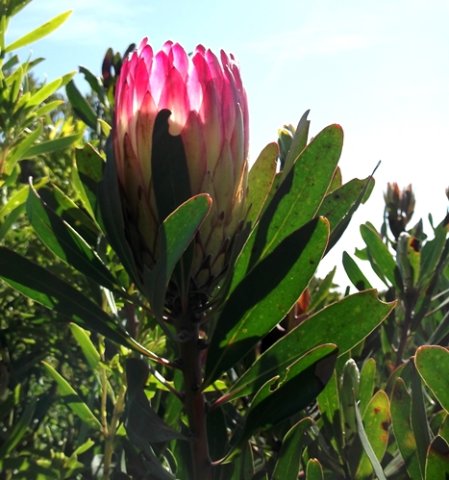Protea obtusifolia against the light

Author: Ivan Lätti
Photographer: Thabo Maphisa
Leaf and bract translucence of Protea obtusifolia appears against sunlight. The marked difference in bract attractiveness between the upper and lower ones is accentuated by the translucence at the top.
The leaves reach just far enough to expose the brightest of the involucre to the world of pollinators. Protection is counterbalanced against reproduction objectives.
Protea leaves get eaten. Not the choice you would make for your green salad, but fortunately there are those that choose differently on the basis of poorly understood needs, so cut them some slack. The spread of tastes in food has been crafted through evolution to reach everywhere, wasting nothing that might be remotely edible to something that wriggles.
Thus are the ways of regulating the competition for ensuring the continuation of life in some form, going for maximum speciation. In other words, increasing biological diversity facilitates (or accommodates?) continually more life forms, thereby life itself. For life does not care about what lives, as long as something continues living.
While the scramble for everything edible is strong, sometimes ferocious, “vacuums” in the form of neglected biological material and discards are filled by every conceivable particle becoming food to yet another kind of organism. Let it ripen, let it rot: everything that dies is continually being marinated, dried or transformed in some way into some dish, (read prepared), to suit the tastes and metabolic requirements of something different that will suck, bite, ingest or absorb directly.
Every bit of detritus reminds of hunger in some weird and wonderful way. Every organism with or without a name in the world of people is a player in the earth's eat and be eaten festival. All eat to build energy for reproduction, for every organism has a limited lifetime. Its purpose is ensuring offspring to keep its species on the list of the living. That's the deal from Mother Earth: All you living things keep going to scratch my back!
And there's more: Inside every big or small body there are more tiny bodies, sometimes millions or billions of them, team players that live to sustain or destroy their host, all doing their thing by eating, multiplying and being eaten in their own specialised environments.
Plants perform their food provision service directly, “on the root” while they live, as well as posthumously when all their parts get eaten, transformed and re-used in multifarious ways. Herbivores, be they mammals, insects or whatever, eat the live plants where they grow, as these P. obtusifolia leaves bear testimony.
Transportation and storage being such challenges in this world, so where better than a stomach? Such a handy appliance to have been crafted by trial and error over countless generations. It must have taken time and lots of failed attempts, but now it exists in countless forms, the stomach having morphed into millions of shapes, sizes and types in the large range of belly-blessed species. What thing on earth had the first true stomach, the mother of all bellies?
Ecology is like a multidimensional jigsaw puzzle, continually differentiating more pieces and more contexts for them to fit together. All the parts live interactively, remaining one puzzle, one overall system comprising interdependent components, one continuous life.
You are part of it, not a cut above. You have more nieces and nephews than you know or ever would want to know you.

